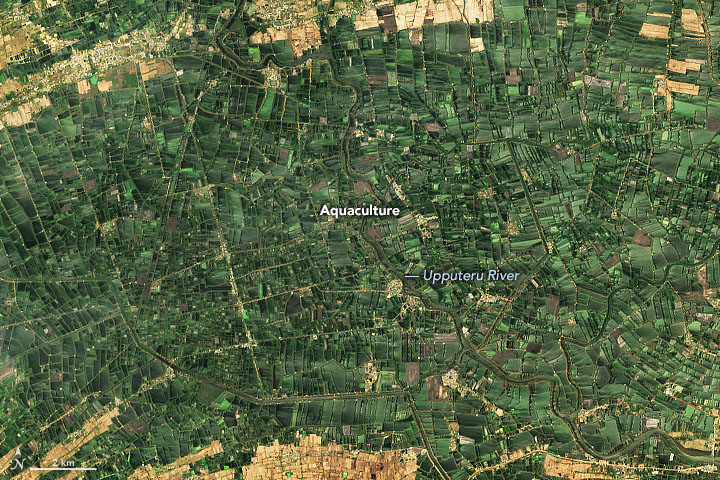


Today’s story is the answer to the July puzzler.
In recent decades, aquaculture has boomed in Andhra Pradesh. The state has become one of India’s largest producers of farmed fish and shrimp. Among the reasons for the boom: a major expansion of inland aquaculture farms along rivers and canals where people once raised crops.
The Operational Land Imager (OLI) on Landsat 8 acquired this natural-color image of an area dense with inland aquaculture ponds along the Upputeru River on June 8, 2021. Aquaculture ponds appear dark green. Farmland is generally brown. Coastal areas with mangrove forests are lighter green.
According to satellite imagery, aquaculture was scarce in this area in the mid-1980s. Now carp, catfish, and other types of finned fish are commonly raised in the area. There are numerous shrimp ponds, too, which tend to be the narrower plots, according to one satellite survey of the area.
The Indian government established the first aquaculture ponds in this area in the 1970s around Lake Kolleru. Since then, the initial success of those projects has made aquaculture an appealing and profitable choice for many farmers in the region who regularly dealt with crops being flooded, the intrusion of salt into water used for irrigation, and Bay of Bengal cyclones.
Despite the expansion, India’s aquaculture sector has faced challenges recently. One recent study calculated that its shrimp farming sector may have lost as much as $1.5 billion in 2020-2021 due to disruptions related to the pandemic. The state of Andhra Pradesh accounts for about 70 percent of India’s shrimp production.
NASA Earth Observatory images by Joshua Stevens, using Landsat data from the U.S. Geological Survey. Story by Adam Voiland